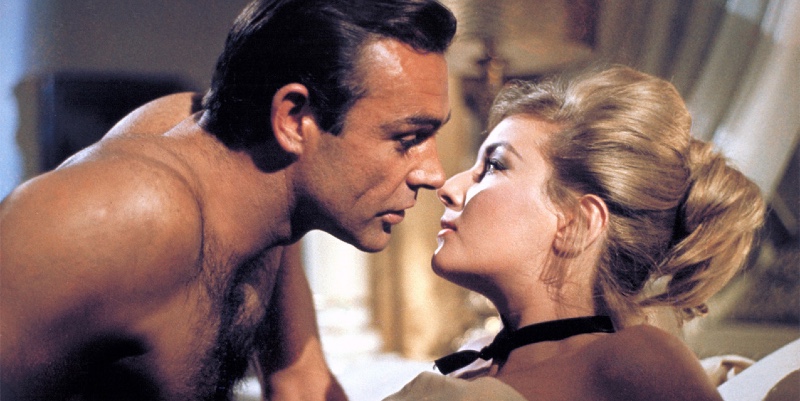The Bond Girl. The phrase itself is a source of celebration and contention. Few other thriller writers before Ian Fleming placed such emphasis on creating rounded female protagonists with their own backgrounds, motives and agency. Few other action films attract such attention with the question of who will play the next female lead. At the same time, the word “girl” rather than “woman” suggests a childlike, even subservient helplessness. Bond would never be described as a “boy” rather than a “man”. A possessive apostrophe seems to hover nearby in invisible ink: Bond’s Girl – defining these women by their relationship to a man. Such duality reflects both the sexist reputation of James Bond and the often-overlooked legacy of women in the world of 007.
As a lifelong Bond fan and feminist myself, I am often asked how both can be true at the same time. There is the sexist image of Bond – recently, a clip went viral showing Sir Sean Connery as James Bond in Goldfinger slapping Dink on her bikinied bottom with a dismissive, ‘Man talk.’ It’s not hard to find moments of sexism across the novels and films. However, to dismiss Bond on these terms would be not only to deprive ourselves of something rare in culture – a character who lives beyond the page or screen in popular imagination, an elite rank shared with the likes of Sherlock Holmes and Peter Pan – but also to deprive ourselves of the opportunity to examine the culture that produced such a character. On top of that, we’d miss out on Fleming’s inimitable style. I first read a Bond book when I was twelve or thirteen, and have been transfixed since then by his uncanny imagery, vivid and journalistic eye, taut suspense next to exquisitely flowing sentences, wit and wisdom.
The literary and cinematic Bond of the fifties and sixties represents both post-war feminism and the backlash against it. Taken as a whole, we might say the James Bond films are a series of lasting images. Yes, one of those images is James Bond dismissing a woman with the words ‘Man talk.’ Yet another is Connery warning Honor Blackman’s Pussy Galore that Goldfinger ‘kills little girls like you.’ Honor Blackman’s arch reply: ‘Little boys, too.’ What an icon.
I’ve always felt the role of women in Bond deserves more credit. Ian Fleming writes women who are independent, capable, courageous, witty, intelligent, vulnerable, dangerous, haunted. They are often orphaned or exiled; pursuing careers that defy expectation, whether as a journalist or a Special Branch agent; or attempting to survive and escape abusive men, whether as a mistress or a smuggler in a diamond chain.
Take these moments across three books where Bond meets ‘The Bond Girl’ and adds up his impressions:
“She might sleep with men, obviously did, but it would be on her terms and not theirs.”
– On Domino in Thunderball (1961)
“She was beautiful in a devil-may-care way, as if she kept her looks for herself and didn’t mind what men thought of them, and there was an ironic tilt to the finely drawn eyebrows above the wide, level, rather scornful grey eyes that seemed to say, ‘Sure. Come and try. But brother, you’d better be tops.’”
– On Tiffany Case in Diamonds are Forever (1956)
“The whole picture seemed to say, ‘Now then, you handsome bastard, don’t think you can “little woman” me. You’ve got me into this mess and, by God, you’re going to get me out! You may be attractive, but I’ve got my life to run, and I know where I’m going.’”
– On Tilly Masterton in Goldfinger (1959)
I’ve got my life to run, and I know where I’m going. There is a strength here that might surprise people. There is also a depth to these characters that might surprise. Take, for example, The Spy Who Loved Me, which bears zero resemblance to the Sir Roger Moore film of the same name. This is one of my favourites, the only Bond novel Fleming wrote in first person, told from the perspective of protagonist Vivienne Michel. Part One, titled ‘Me’, details with empathy Vivienne’s struggles as a single, professional woman in sixties London, smashing against the glass ceiling and going through an abortion alone. I first read this as a teenager –Vivienne’s experience aged seventeen facing sexual pressure from her boyfriend to ‘be a sport’ rang true then, and still rings true for women now. Or take Thunderball, where we are treated to one of Fleming’s greatest introspective passages, as Domino tells the story of her life through the lens of a fantasy she constructed growing up inspired by the illustration on a packet of Players cigarettes.
This depth of character creates a convincing and distinctive female gaze, which Fleming turns on Bond. Gala Brand is an undercover Special Branch agent. One of my favourite characters, she never made it to film. Here’s Brand assessing Bond after meeting him for the first time in Moonraker (1955):
“Commander Bond. James Bond. Clearly a conceited young man like so many of them in the Secret Service. … He could probably shoot all right and talk foreign languages and do a lot of tricks that might be useful abroad. But what good could he do down here without any beautiful spies to make love to.”
Gala Brand is primarily concerned that Bond will ‘blow her cover by doing something stupid.’ I love that Fleming gives us such a driven, cool-headed female agent in 1955, a time when post-war advertising was urging women to leave work and get back to the kitchen.
And here are Vivienne’s thoughts on Bond in The Spy Who Loved Me (1962) after she answers the motel door, desperately hoping for someone to help her against the gangsters who have taken her captive:
“At first glance I inwardly groaned – God, it’s another of them! He stood there so quiet and controlled and somehow with the same quality of deadliness as the others. And he wore that uniform that the films make one associate with gangsters – a dark blue, belted raincoat and a soft black hat pulled rather far down. He was good-looking in a dark, rather cruel way and a scar showed whitely down his left cheek. I quickly put my hand up to hide my nakedness. Then he smiled and suddenly I thought I might be all right.”
This is a rare opportunity to see Bond through someone else’s eyes, and not as the hero of the story, but as a passing battleship in the night. We’re so used to judging Bond by his own self-perception that it’s a shock to the system that these ‘years of treachery and ruthlessness and fear’ have left him with the ‘same quality of deadliness’ as the villains. That Fleming does this through the eyes of Vivienne underlines the significance of his female characters.
The Bond of the novels experiences a character arc perhaps not seen in the films until Daniel Craig’s tenure, one that’s in many ways defined by his relationships with women. Bond’s journey begins with his love for Vesper Lynd, a British operative forced to become a double agent under duress. Her seeming betrayal and suicide leaves Bond with a ‘cold heart’. But his relationships aren’t actually all that cold, only fleeting. After a passionate journey on a train with Jill Masterton, there are no ‘regrets’ for either character: “Had they committed a sin? If so, which one? A sin against chastity?” This is the Bond of 1960s Free Love. (Or it would have been if Goldfinger hadn’t murdered Jill by painting her gold.) Bond cares for the women he connects with even if he knows it won’t last. He tells Domino that he loves her before she leaves to risk everything in a bid for revenge against Emilio Largo. He leaves Vivienne a note urging her to contact the Secret Service if ‘you ever want me or need any help’. There is something about the phrase If you ever want me that I find desperately lonely.
Towards the end of his arc, Bond meets Tracy in On Her Majesty’s Secret Service and his heart thaws. Bond realises, “I’ll never find another girl like this one. She’s got everything I’ve ever looked for in a woman. She’s beautiful, in bed and out. She’s adventurous, brave, resourceful. She’s exciting always.” After grieving for Vesper and avoiding lasting relationships, Bond realises he is ‘fed up of all these untidy, casual affairs that leave me with a bad conscience. I wouldn’t mind having children.’ He and Tracy are ‘two of a pair, really. Why not make it for always?’
But their happiness is not without a shadow for long. Blofeld murders Tracy hours after the wedding, freezing Bond’s development, stopping his watch as he cradles her dead body in the crashed car and yet tells the patrolman: ‘we’ve got all the time in the world.’ In Fleming’s final novel, The Man with the Golden Gun (1965), Bond ends the series with the realisation that while he might find happiness with Mary Goodnight, his former assistant and now Number Two at Station J, he can never commit to a lasting relationship, never commit to peace, never commit to stability in the same room with the same view.
Many of the women in Bond’s world, from books to films, have achieved iconic status: Vesper, Tracy, Honey Ryder, Pussy Galore, Octopussy, Dr Holly Goodhead. (The names alone call for a whole other essay.) I grew up as Pierce Brosnan’s Bond hit the screen – I fell in love with a hero who was attracted to accomplished women who weren’t fools and didn’t suffer them either. Natalya Simonova, a computer programmer to whom the mission is just as personal as it is to Bond. Wai Lin, a secret agent played by Michelle Yeoh in a role that catapulted her to Hollywood stardom. Elektra King, the only female arch-villain of the franchise. And, of course, Dame Judi Dench cast as M, a defining moment in cultural history because it became so much more than just a moment. The world of Bond remains evergreen because it evolves and is capable of self-reflection. Judi Dench’s M begins by calling Bond a ‘sexist, misogynist dinosaur’ and a ‘relic of the Cold War.’ From here, M and Bond go on to form the most meaningful and lasting relationship of all, until she dies in his arms in Skyfall (2012), telling him that he is the one thing she got right. Reader, I cried in the cinema.
And that’s only the women in front of the camera. Behind the camera, the first two James Bond films were co-written by the real-life Johanna Harwood. Dana Broccoli and Jacqueline Saltzman were both true creative partners to producers Albert “Cubby” Broccoli and Harry Saltzman. Barbara Broccoli has now helmed the films for decades alongside her stepbrother Michael G. Wilson. Eileen Sullivan was the wardrobe mistress for the first five Bond films. Daniel Craig, whose style has grabbed headlines and shaped men’s fashion, has benefited from a run of incredible costume designers: Lindy Hemming, Louise Frogley, Jany Temine and Suttirat Larlarb. Debbie McWilliams has been casting Bond films for over forty years. Phoebe Waller-Bridge co-wrote No Time to Die (2021). The list goes on and on.
Women have also played crucial roles in the evolution of the novels, from artist Pat Marriott’s striking covers for the first editions of Diamonds are Forever and Dr. No, to Fay Dalton’s celebrated illustrations for the Folio Society, which I display proudly beside my desk. Samantha Weinberg put Moneypenny centre stage in her series The Moneypenny Diaries. The Fleming family continue to shepherd the books. Ian Fleming’s nieces, Kate Grimond and Lucy Fleming, have been deeply involved in the family business since the 1970s. Literature is in their blood. As part-owners of the company and spokespeople for the Estate, Kate and Lucy’s shared passion has ensured that Ian Fleming Publications is still flourishing over 114 years since Ian was born. Today, the next generation of Flemings – Kate’s daughter Jessie Grimond, working with Diggory Laycock and Fergus Fleming – are honouring their legacy whilst looking to the years ahead. The company has benefited from talented editors, including Kate Jones, Zoë Aquilina, Sarah Fairbairn, Josephine Lane, and my initial editor on the Double O series, the luminous Phoebe Taylor. Corinne Turner first became involved with Ian Fleming Publications Limited in 1988, and has led Ian Fleming Publications as Managing Director since 1999. Corinne has been an inspiring and guiding light for me, endlessly encouraging, classy and cool – so much so that 003 drives Corinne’s car.
Just as the history of the Secret Service itself is the story of women and men – something Ian Fleming personally experienced as a Commander in the Intelligence Office during World War Two with close female colleagues – so is the story of James Bond. Maryam d’Abo, who starred opposite Timothy Dalton in The Living Daylights, writes that ‘being a Bond Girl was… about being independent enough to stand alongside James Bond and all his history.’ The women of Bond stand in their own history, creating a legacy that will last forever. I feel humbled to step forward and stand alongside them.
Bibliography
GoldenEye. Directed by Martin Campbell. United Artists, 1995. Film.
d’Abo, Maryam and Cork, John. Bond Girls are Forever: The Women of James Bond. London: Boxtree, 2003.
Goldfinger. Directed by Guy Hamilton. United Artists, 1964. Film.
Fleming, Ian. From Russia with Love. London: The Folio Society, 2016.
Fleming, Ian. Moonraker. London: The Folio Society, 2017.
Fleming, Ian. Goldfinger. London: The Folio Society, 2018.
Fleming, Ian. Diamonds are Forever. London: The Folio Society, 2018.
Fleming, Ian. Thunderball. London: The Folio Society, 2019.
Fleming, Ian. The Spy Who Loved Me. London: The Folio Society, 2020.
Fleming, Ian. On Her Majesty’s Secret Service. London: The Folio Society, 2020.
Fleming, Ian. The Man with the Golden Gun. London: The Folio Society, 2021.
Skyfall. Directed by Sam Mendes. United Artists, 2012. Film.


















